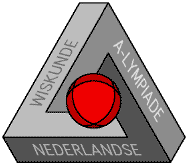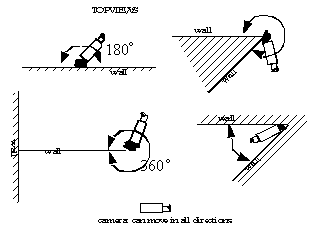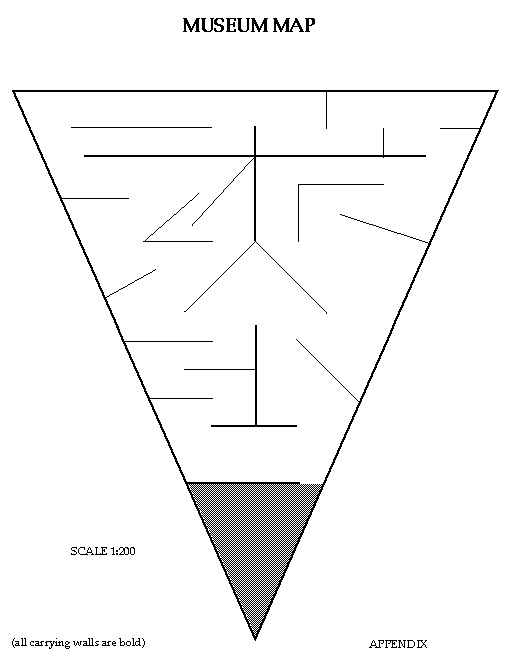 Math A-lympiad:
Preliminary 1996-1997
Math A-lympiad:
Preliminary 1996-1997
Security is an art on itself
Introduction
A museum for modern art will organize a big exhibition with pieces of a
number of great artists in the field of modern art. The organization is
busy with preparations for the exposition, and they meet with difficulties
concerning security.
A new security system
The present security system with video cameras doesn't satisfy the demands
of an exhibition this size. The cameras aren't movable enough (to show
another corner), but the main objection is, that the present system cannot
cover the complete space in the museum. To organize the exposition, it's
necessary to get a new security system.
The new type of camera that will be used, is already chosen. This camera is
so fast in moving (in all directions) and focussing, that one can say that this
camera really secures the complete surrounding space (see the figure below).
All walls in the museum go from floor to ceiling.

A disadvantage of this camera is its high price. That's why it's necessary
to investigate carefully where the cameras should be placed, for you want
the least possible amount of cameras.
Enclosed is a map of the museum. The museum has a triangular formed
topview. The grey part contains the entrance, bathrooms, cloakroom and
office rooms. It's not necessary to replace the old cameras in this part.
The new security system is just needed for the part that is not grey.
Question 1
Think of a placement of cameras, in such a way that you use the smallest
possible amount of cameras to secure the exhibition room.
Describe the system you used to come to this placement of cameras.
Mark where the cameras should be placed and show that the whole exhibition
room will be secured this way.
The exhibition contains a little less than 100 paintings. To show these
paintings in a proper way (with enough space in between), at least 280
meters of wall capacity is needed, but: the more wall capacity, the better.
On the map, you can see a number of bold walls. These are carrying
walls; the other walls can be removed.
Because the new security system is very expensive, the organization
wants to reduce the expenses. To do this, there is the possibility to reduce
the number of cameras, but there is also the possibility to remove non-carrying
walls. Removement of wall costs f500,- per meter. A video camera costs
f10.000,- each.
Question 2
How is it possible through removing walls (keep the minimum amounts of
capacity you need in mind!), to save expenses on the cameras? In other
words: how is it possible, by removing as little wall capacity as possible,
to make as many cameras as possible superfluous? And yet, all walls stay
secured?
Make a proposal and calculate the savings that this solution will give
you.
After this exhibition, the inside of the museum will be changed drastically.
First, all non-carrying walls will be removed and just the carrying walls
will stay. Because the new inside of the museum will be used for a longer
period of time, and for several more exhibitions, an architect agency will
be hired to create the new inside. The assignment will be to add 150 meters
of wall capacity to the existing carrying walls. Furthermore, 6 cameras
must be sufficient for security, yet, there must be an attractive partition
of space.
Question 3
A number of architect agencies is being asked to hand in proposals in which
the conditions are met.
Your team works for one of the architect agencies, and your agency
really wants the assignment. Of course you won't be a strong rival if you
just meet the minimum demands.
Make a proposal for the museum board (including working drawing and
short `covering letter').

 Math A-lympiad:
Preliminary 1996-1997
Math A-lympiad:
Preliminary 1996-1997 Math A-lympiad:
Preliminary 1996-1997
Math A-lympiad:
Preliminary 1996-1997
